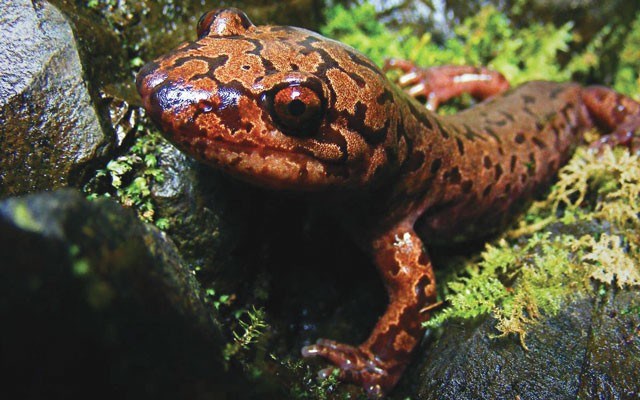As a PhD student at the University of Toronto back in the day, I shared an office at the Royal Ontario Museum with a guy named Hugh Griffith. Fifteen years later, having found ourselves both living on Canada's West Coast, we'd connected and set out on a series of good ol' fashioned critter-quests. This is the kind of thing that herpetologists — those who study reptiles and/or amphibians — are wont to do. There was always beer involved, of course, but our main aim was generally to observe some animal or another in the wild. Given the wealth of experience between us, spanning deserts, jungles, wetlands and grasslands around the globe, we found plenty, even within the urban confines of the Lower Mainland. One animal that continued to elude us, however, was the elusive Coastal Giant Salamander, Dicamptodon tenebrosus. Scarce at this extreme northern edge of a largely coastal distribution that begins in California, the species' range is further fragmented in Canada by logging. Very fragmented, in fact. Nevertheless, the few-and-far-between bits of the south side of the Fraser River Valley that remained unaltered were perfect for Dicamptodon, a long-lived denizen of cool, montane forest laced by streams that ratchet from pool to idyllic pool up steep hillsides.
I'd hunted for the beast here diligently on numerous occasions over a 20-year span, with each outing ending in failure. Though the lengthy pub debriefing that Hugh and I conducted in Richmond after our first giant-salamander outing was a raging success, our attempt to find the creature had not been. Frustrated once more, a clear challenge to our treasure-hunting skills demanded we return.
Turning off the highway near Cultus Lake on our second try a few weeks later, dense forest evoked a visage of Middle Earth, mystic and mythical. If Bigfoot existed, this creeping, moss-encrusted understory was just the place to spot it, though we'd settle for a giant salamander or two. The first stream we ascended seemed ideal for Dicamptodon's large and predatory larvae, which spend several years in the water. Likewise the surrounding forest floor for adults, which hunt by night for prey ranging from insects to earthworms to other amphibians and, it has even been reported, baby mice. But despite careful searching of the area we were once again finding a whole lot of nothing. Moving onto the banks, we raked through the abundant forest debris and its coating of microscopic plants — a riot of opportunity germinating in a quiet of decomposition — turning out only the wriggling forms of numerous Western Red-backed Salamanders, Plethodon vehiculum. Still, it was something, and this was what much of herpetology was about for both of us: simply finding hidden life, things no one else knew were there.
This population of red-backs around Cultus Lake is actually unusual in its polymorphism, displaying mid-dorsal stripes of blood-red, orange, or bright yellow in variously broken patterns and even all-black forms. Ironically, for all the multifarious variation within our own species, Homo sapiens, polymorphism is a strangely difficult thing for people to grasp. As collectors and classifiers we like things simple: if it's long and brown it's this; short and green it's that. This, however, is not the way of the natural world, and Hugh and I well knew that the seemingly superfluous collections of museums were one way to keep tabs on the otherwise confounding range of variation offered by some species. Much as museum collections also keep tabs on the distributional limits of species. Given the vicissitudes of time (and logging) there may not have been any map to where we actually might find Dicamptodon any more, but a jar in a museum somewhere put a giant "X" over this general area. Where were they?
Half a day and half a dozen streams passed under our probing fingers. Soaked, muddied, scratched and bleeding, we made our way into one final steep, V-shaped stream through a choke of waist-high vegetation that tore at our clothing and raking bright red lines into the bare skin of our legs. Hugh pointed out ferns, Devil's Club, Vanilla Leaf, Stinging Nettle and ubiquitous invasive Himalayan blackberry. He knew all about these plants now, he told me, because he'd been working as an "overqualified interpretive naturalist." He'd also just finished writing a novel that followed a bitter and (of course) overqualified naturalist who was for some reason sought out by a famous wildlife artist and old camp mate that he hadn't seen in decades. In that story, improbably, long-lost buddy also accompanies the protagonist on a search for Dicamptodon. Reading Hugh's novel months later, I realized that not only had our lives on these critter quests been eerily imitating art, but that he'd anticipated it long before it occurred — especially because it's the naturalist's friend in the story who finally unearths their quarry.
After hours on hands and knees that final day, I'd reached dejectedly into the hollow under a crumbling stump only to have my hand emerge with living compost; from a pile of black detritus an eye blinked back at me from 370 million years ago, then another, and soon the gold-and-copper-flecked mottling of a stout, 15-centimetre Pacific Giant Salamander materialized. I shouted and held it aloft above the canopy of ferns so Hugh, on the other side of the stream, could see. His smile was the smile of a child, a pirate, a scientist and, tellingly, an author.
Another hard-won find. More hidden life.
Leslie Anthony is a Whistler-based author, editor, biologist and bon vivant who has never met a mountain he didn't like.




